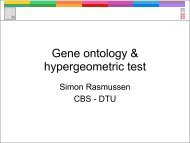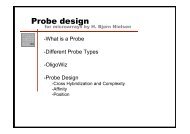Computational tools and Interoperability in Comparative ... - CBS
Computational tools and Interoperability in Comparative ... - CBS
Computational tools and Interoperability in Comparative ... - CBS
You also want an ePaper? Increase the reach of your titles
YUMPU automatically turns print PDFs into web optimized ePapers that Google loves.
up to a total of 41 different E. coli<br />
genomes (accord<strong>in</strong>g to the National Center<br />
for Biotechnology Information,<br />
NCBI Entrez, 12-Feb-2008). Table 1 lists<br />
the top 20 represented prokaryotic<br />
genera <strong>in</strong> terms of numbers of fully<br />
sequenced genomes based on recent<br />
count<strong>in</strong>g <strong>in</strong> Entrez Genome Projects,<br />
although these numbers will change<br />
quickly as more genomes are be<strong>in</strong>g<br />
added on a regular basis. Thus, analysis<br />
of multiple genomes of the same organism<br />
(the ‘‘pangenome’’) is now possible,<br />
<strong>and</strong> as more metagenomic datasets are<br />
published (see for example the projects<br />
listed on the GOLD web pages 24 ), there<br />
is a need for a graphical representation<br />
of how these new data compare to exist<strong>in</strong>g<br />
reference stra<strong>in</strong>s or model organisms.<br />
We have developed a visualization<br />
method, called ‘‘BLASTatlas’’, for show<strong>in</strong>g<br />
mapped alignments of BLAST<br />
searches of a reference sequence aga<strong>in</strong>st<br />
one or more databases, onto the reference<br />
genome. Early implementation of a<br />
similar method 2–4 accounted for the statistical<br />
significance (E-value) of each hit,<br />
by color cod<strong>in</strong>g the expectation values<br />
[ log(E)] of the alignment. This method<br />
gives a uniform color throughout the<br />
alignment (gene or prote<strong>in</strong>) but shows<br />
no <strong>in</strong>formation about the am<strong>in</strong>o acid<br />
conservation with<strong>in</strong> regions of the alignment.<br />
At the level of a bacterial chromosome,<br />
this makes little difference,<br />
although when one zooms <strong>in</strong> at the level<br />
of <strong>in</strong>dividual genes, the older method of<br />
shad<strong>in</strong>g the entire gene based on the Evalue<br />
gives no <strong>in</strong>formation about regions<br />
with<strong>in</strong> a gene (such as functional doma<strong>in</strong>s)<br />
which might be strongly conserved,<br />
whilst other parts of the gene<br />
have little sequence homology with<strong>in</strong><br />
other genomes. We have ref<strong>in</strong>ed the<br />
BLASTatlas method to map each<br />
<strong>in</strong>dividual am<strong>in</strong>o acid residue or<br />
nucleotide back to the reference genome<br />
sequence from which the cod<strong>in</strong>g sequence<br />
was derived. Instead of colourcod<strong>in</strong>g<br />
the significance of the entire hit,<br />
this method maps the conservation of the<br />
<strong>in</strong>dividual bases or am<strong>in</strong>o acids. Tools<br />
such as the Artemis Comparison Tool<br />
(ACT) 5 allow detailed view<strong>in</strong>g of complete<br />
BLAST results, <strong>and</strong> this is an<br />
excellent graphical method for comparison<br />
of two genomes. ACT can also be<br />
extended to compare two genomes to a<br />
reference, placed <strong>in</strong> the middle. In<br />
contrast, the BLASTatlas method can<br />
compare many genomes to the same<br />
reference, <strong>and</strong> can provide a quick overview<br />
of chromosomal regions of gene<br />
conservation across many genomes.<br />
As can be seen from Table 1, for many<br />
of the heavily sampled genera, there are<br />
further genome projects <strong>in</strong> the pipel<strong>in</strong>e<br />
which will produce even more sequences<br />
than are currently available, <strong>and</strong> there is<br />
a need for methods for efficient comparison<br />
of these genomes, giv<strong>in</strong>g an overview<br />
of general trends <strong>in</strong> the data. The<br />
Table 1 The number of species <strong>and</strong> NCBI Entrez Project IDs of the 20 most represented genera<br />
<strong>in</strong> the Entrez Genome Projects Database, 13 as accessed on 21 October 2007. The numbers <strong>in</strong><br />
brackets show the count<strong>in</strong>g of both ongo<strong>in</strong>g <strong>and</strong> completed projects, whereas the first number<br />
reflects only the completed projects. C<strong>and</strong>idate genera have been excluded from this count<strong>in</strong>g<br />
Genus Projects Species<br />
Streptococcus 26 [63] 8 [15]<br />
Burkholderia 15 [55] 8 [15]<br />
Bacillus 16 [48] 9 [16]<br />
Clostridium 14 [43] 9 [22]<br />
Vibrio 7 [35] 5 [14]<br />
Mycobacterium 16 [30] 9 [14]<br />
Salmonella 5 [30] 2 [3]<br />
Listeria 4 [29] 3 [6]<br />
Escherichia 10 [27] 1 [1]<br />
Mycoplasma 13 [25] 11 [17]<br />
Shewanella 14 [24] 10 [15]<br />
Pseudomonas 13 [23] 7 [8]<br />
Yers<strong>in</strong>ia 9 [23] 3 [7]<br />
Haemophilus 6 [23] 3 [4]<br />
Staphylococcus 17 [22] 4 [5]<br />
Synechococcus 10 [21] 2 [2]<br />
Campylobacter 9 [20] 5 [9]<br />
Francisella 7 [16] 1 [2]<br />
Lactobacillus 11 [15] 10 [12]<br />
Rickettsia 10 [15] 9 [12]<br />
BLASTatlas allows the comparison of<br />
many genomes to a reference sequence.<br />
The current limit is about 60 genomes.<br />
There are two levels of comparison, the<br />
first represents a one-page map of the<br />
whole chromosome, <strong>and</strong> the second level<br />
zoom<strong>in</strong>g <strong>in</strong> a particular region of <strong>in</strong>terest,<br />
allow<strong>in</strong>g the visualization of regions<br />
of conservation with<strong>in</strong> <strong>in</strong>dividual genes.<br />
The color-cod<strong>in</strong>g represents identical<br />
am<strong>in</strong>o acids (or nucleic acids), based on<br />
a pairwise alignment of all prote<strong>in</strong> cod<strong>in</strong>g<br />
regions, with the best matches for<br />
each gene <strong>in</strong> the reference genome<br />
shown. Thus, comb<strong>in</strong><strong>in</strong>g both levels, it<br />
is possible to get a global overview of the<br />
whole chromosome, <strong>and</strong> to then quickly<br />
identify gene conservation (or lack thereof)<br />
<strong>in</strong> regions of <strong>in</strong>terest, at the level of<br />
conservation of <strong>in</strong>dividual am<strong>in</strong>o acid<br />
residues.<br />
Clostridium botul<strong>in</strong>um is an important<br />
human pathogen which is the causative<br />
agent of botulism, giv<strong>in</strong>g rise to fatal<br />
paralysis of the respiratory muscles,<br />
caused by botul<strong>in</strong>um neurotox<strong>in</strong> (BoNT)<br />
which disrupts nerve functions. The<br />
genes encod<strong>in</strong>g BoNT components are<br />
clustered on the bacterial chromosome<br />
(group I + II stra<strong>in</strong>s), on prophages<br />
(group III stra<strong>in</strong>s) or on plasmids (group<br />
IV stra<strong>in</strong>s). Group I stra<strong>in</strong>s encode type<br />
A, B <strong>and</strong> F type tox<strong>in</strong>s, group II stra<strong>in</strong>s<br />
produce type B, E <strong>and</strong> F tox<strong>in</strong>s <strong>and</strong><br />
group III stra<strong>in</strong>s encode for type C <strong>and</strong><br />
D tox<strong>in</strong>s, whereas group IV stra<strong>in</strong>s<br />
produce type G tox<strong>in</strong>. 6 We use the<br />
BLASTatlas method to show the overall<br />
genome homology of the C. botul<strong>in</strong>um<br />
stra<strong>in</strong> F Langel<strong>and</strong>, compared to all<br />
currently available <strong>and</strong> fully sequenced<br />
stra<strong>in</strong>s of the Clostridium genus.<br />
Methods<br />
The BLASTatlas method uses all the<br />
provided annotated cod<strong>in</strong>g sequences<br />
(or prote<strong>in</strong>s) of a reference genome, <strong>and</strong><br />
compares each of those with one or more<br />
genomes. The total genome sequence for<br />
each organism is represented by a database<br />
<strong>and</strong> can conta<strong>in</strong> any number of<br />
DNA or prote<strong>in</strong> sequences. BLAST<br />
searches with a non-str<strong>in</strong>gent E-value<br />
cut-off of 0.01 are used to identify the<br />
best alignments between the reference<br />
sequence prote<strong>in</strong> <strong>and</strong> the database<br />
(genome) <strong>in</strong> question. Once identified,<br />
the s<strong>in</strong>gle best pairwise alignment for<br />
364 | Mol. BioSyst., 2008, 4, 363–371 This journal is c The Royal Society of Chemistry 2008









